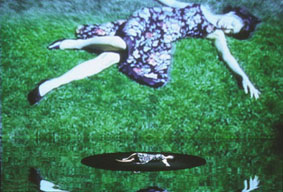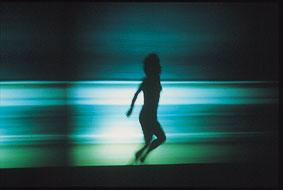

Voyage © Emmanuel Valette

memorandum © Emmanuel Valette

[OR] © Emmanuel Valette
PLAN FOR SLEEP (1984-86) … EVERY DOG HAS HIS DAY (1985) … THE ORDER OF THE SQUARE (1985) … 036 PLEASURE LIFE (1987) … PLEASURE LIFE (1988) …
pH (1990–93) was Dumb Type’s largest scale work to-date integrating performance, installation, video, and printed material. The audience’s seats lined up above both sides of a slender sixteen-meter white linoleum floor. On the stage a horizontal bar moved across the floor suggesting a giant photocopy machine. Installed on the bottom surface of the bar were a number of slide projectors, which projected images onto the floor where performers (human beings) acted and danced under the mercy of and/or against the machine (society).
S/N (1992-96) was triggered by the former director Teiji Furuhashi’s infection by the HIV virus that causes AIDS, the political issues of AIDS, and, more significantly, Dumb Type’s overriding interest in how individual identity is conditioned within each individual’s self. The performance challenged the fine line between the fiction of theatre and reality through its unusual ‘live’ talk show style (in which Teiji himself comes out, together with a couple of other performers, as “homosexuals” and “HIV positive”). A wide range of images, texts and vignettes surrounding such themes were combined with strikingly new dance as well as video and slides, lighting and sounds. The piece reverberated across many groups in society; its message “what can art do for society and the individual?” shocked both the theatre and the visual arts community, as well as the general community and activists, all living with the HIV/AIDS crisis.
[OR] (1997-1999) was created in France in March 1997, following a one-month residency at the Théâtre du Manège in Maubeuge. [OR] is a reflection on the border(s) between life and death, the meaning of its title ranging from the binary system, to the alternative A or B, the 0 (zero) radius, an operation room. Some of the most advanced techniques combined the human body and various media to elicit a range of viewpoints, whether religious, philosophical, medical, cultural, or emotional, onto a blinding-white stage that consisted of a circular floor and semi-cylindrical wall.
Dumb Type described the work as being “about the state of ‘white out’ like in a blizzard, where you are deprived of ability to see, where you can’t recognize anything, where you don’t know where you stand anymore, where you may not know whether you are alive OR dead. But what distinguishes one from the other? Where is the border? What is death? What is it?”
memorandum (1999-2002): the first version of this show was presented in October 1999 by Le Manège, Scène Nationale de Maubeuge (FR). The final version was premiered at the New National Theatre of Tokyo on November 27th 2000. Combining elements of multimedia, dance and fragmented narrative, memorandum explores the hazy dimensions of recall that ground and disquietly erode our experience minute-by-minute.
Voyage, premiered at the Théâtre National de Toulouse in 2002 (FR), was the last performance of the company on tour until 2009.
A new multimedia show was
commissioned by the ROHM Theatre in Kyoto in 2019. The work in
progress was presented at the KYOTO STEAM — International Arts x
Science Festival.
Art installations produced by Dumb Type
include LOVERS
(Dying Pictures, Loving Pictures), created in 1994 by Teiji
Furuhashi. It was originally presented in 1995
and one year later acquired by the Museum of Modern Art in New
York, which restored and exhibited it again in 2016. A second
version, produced for the 2001 opening of the Sendai Mediatheque
(JP), was again exhibited internationally and ultimately donated
to the National Museum of Art, Osaka, in 2017.
[OR]
installation, related to the
performance [OR], was commissioned by
the Inter Communication Center (ICC) in Tokyo for its opening in
April 1997. A new version of the artwork was purchased by the
Musée d’Art Contemporain, Lyon in 2000. Both LOVERS
and [OR] have been exhibited
worldwide, among others during Lille 2004 - European Capital of
Culture.
Dumb Type also produced Shiro
Takatani’s frost
frames (1998), Cascade,
based on the performance memorandum,
premiered at the Salone del Mobile of Milan (2000), and Voyages,
related to the performance Voyage,
commissioned and premiered by NTT InterCommunication Center
[ICC] Tokyo in 2002.
Visual imagery and sound from past works [OR],
memorandum and Voyage
have been revisited in a 4 x HD video installation MEMORANDUM
OR VOYAGE, presented at Tokyo
Museum of Contemporary Art in 2014.
In 2018, most of the collective’s artworks have been featured in
a huge monographic exhibition, Dumb Type Actions +
Réflexions, at the Centre Pompidou-Metz. New
versions of LOVE/SEX/DEATH/MONEY/LIFE
(1995), Playback
(1989), pH
(1990) were premiered there, alongside LOVERS,
MEMORANDUM OR VOYAGE, Toposcan/Ireland
(2013) by Shiro Takatani and data.tron
(2007) by Ryoji
Ikeda.
On the occasion of the 35th anniversary of the group’s
formation, an updated version of the exhibition was featured in
2019-2020 at the MOT - Museum of Contemporary Art Tokyo,
including the new installation TRACE/REACT II.
Music projects include Shiro Takatani’s
contribution as artistic director on the first opera LIFE
by Ryuichi Sakamoto, which premiered
in September 1999. In March 1998, Dumb Type
designed the “symphonic novella” by Gérard Hourbette
for the first cycle of Dangerous
Visions, a project of Art
Zoyd and the Orchestre National de Lille,
France, combining philharmonic orchestra and new sound and image
technologies.
